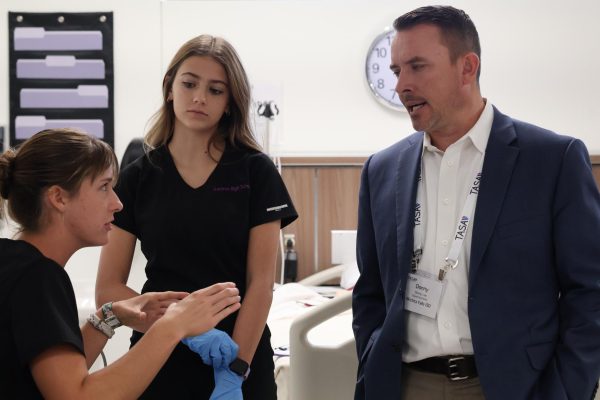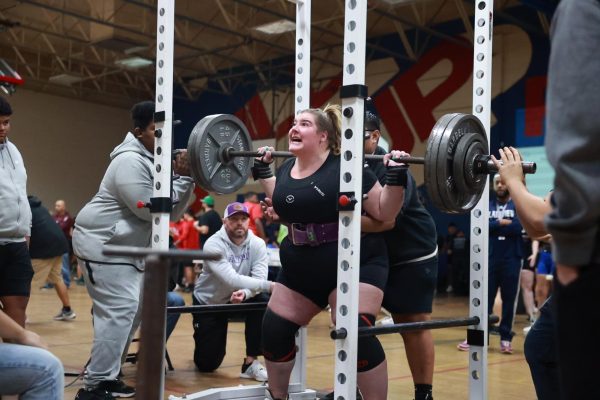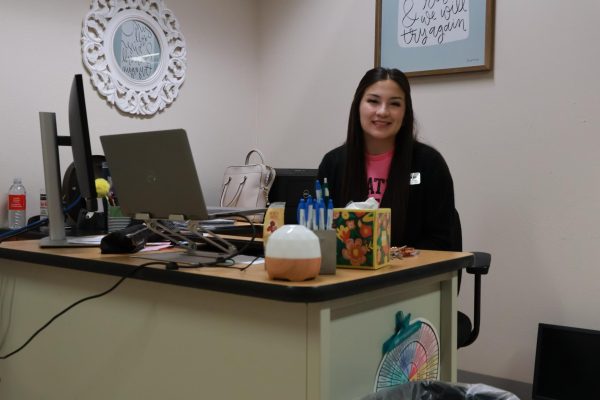Online learning off course
A student scrolls through a Google Classroom page in class.
Pause for a moment, and look at your tabs.
No, really, go ahead. The article can wait a moment.
How many do you have? Is it just this one Eagle’s Tale article, or are you scrolling through Facebook? Perhaps you have a few assignments due in Google Classroom and a recording due in band through Charms Office, so those sites are open along with your Google Drive and a few Docs. Chances are you at least have the games section of Coolmath bookmarked, but maybe you keep it perpetually open as well to survive the monotony of fourth period (the teacher there just goes on and on and on). And perhaps at the end of this trail of tabs is your Gmail account, blinking with notifications every few minutes and summoning you to its corner.
In any case, it’s a safe guess whether you’re a student, parent or teacher, this article is not the only tab you have. A cacophony of .coms refresh and report each new update. For the students reading, that cacophony is ruining learning.
Canyon ISD is in touch with its digital self, but perhaps a bit too much. With this year’s shift to student-owned Chromebooks, the web is more visible than ever in each classroom and on each desk. And yet, this frenzied attempt to keep with the times is damaging the learning process. The high schools especially are moving so quickly they cannot work out the wrinkles in the ever-changing plans. If we wish to move online, we should approach the Internet like online schools do–with one universal system, plenty of learning methods and a focus to complement a live learning method, not replace it.
Online learning is meant to streamline the process of turning in assignments, however students cannot easily turn in assignments if they do not know where to send them. Across the school, no system is preferred–Twitter or GroupMe, Microsoft Word or Google Docs. Students have too many different places to turn in their work (physical boxes in classrooms, Google Classroom, email, Charms Office, student hard drives, Blackboard, Pearson and more). Because each class features a variety of norms, preferences and rules, trying to remember all of the variations only makes returning worksheets and essays tougher.
Ironically, we have fewer hands-on learning opportunities in core classes than the online school did.
— Erin Sheffield, 11
The students did not choose to attend an online school, either. The constant use of laptops and the Internet would make sense for a virtual academy, but it is pointless to get dressed and ride the bus to school only to spend most of the day on a computer. Even at Connections Academy, students were mailed several textbooks and supplies such as safety goggles, oil paints or jump ropes for every class. Ironically, we have fewer hands-on learning opportunities in core classes than the online school did.
Giving students technology and expecting perfectly responsible use is unfortunately naive. The problem is faculty and administration have little control over these devices. Sure, the browsers and wifi block certain websites, but any student can quickly search a way around these blocks and render them useless. Also, texting in class is far easier to get away with when one uses the many messaging sites and services available through a Chromebook’s browser–all one must do is close a tab to hide evidence from teachers. It is easy to waste time with this tool constantly in a student’s hands.
One may argue college students and online students suffer the same troubles–college students frequently use laptops in class, and online students rely entirely upon the Internet, so brick-and-mortar high school students are fine to spend so much time learning online. However, if a college student wastes his time browsing during class, that person alone will suffer the consequences. A professor will not slow down to ensure one student in a 150-person lecture is listening.
Online schools are similar; a student’s laziness will not harm the entire class, just the one student. However, in a brick-and-mortar high school, teachers are expected to wait for all students to understand. Sure, a teacher could allow a student to text in class and waste time, but instead, policy states that teacher should confiscate the phone in order to teach the child to focus on learning. Constant distraction can lead to slower classes, meaning those who did pay attention will be punished by sitting in a boring class listening to teachers once again explain old concepts because the unfocused students wasted time.
Online learning is not bad in and of itself. Taking and organizing notes is far faster with a keyboard. Games such as Quizizz and Kahoot! provide motivation and competition with other students. However, the Internet should be used to enhance learning experiences. Instead, some are using it as a crutch, a way to copy someone else’s entire curriculum in some extreme cases. The lack of collaboration between classrooms and abuse of online tools means students learn less. Telling a class to go watch 30 minutes of YouTube videos instead of teaching one’s subject in the classroom is not an enhancement; it is lethargy.
Our classes call for plenty of tabs. However, the inconsistency in systems, constant distraction and inability to control student activity make the shift to online more negative than positive. Online learning tools should enhance learning and provide extra help where necessary, not provide every worksheet used in a classroom or become a time waster. It is time for the district to close some tabs and focus more on traditional learning.

Hullo! I'm a senior in my third year on staff and my second year as an editor-in-chief. You can catch most of my work in the news and blogs sections. When I'm not around the school with a camera and a press pass, I spend my time in choir, musical, various...













